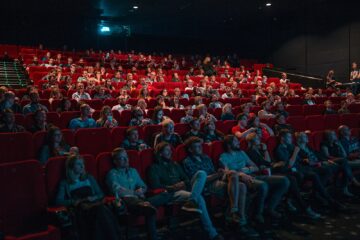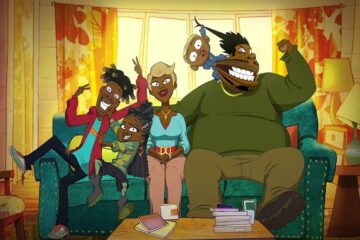Review: “Tell Them We Were Here”
Where can art be found? The “art as commodity” mentality would have you believe it’s found only on exhibit in institutional settings such as galleries and museums. Alternately, this mentality says the paintings and sculptures rich collectors buy or sell should definitely be considered art. But what if art could also be found in a victory garden in a plaza near San Francisco’s City Hall, or creating and fully living a manufactured life for years, or even in re-purposing the pages of a redacted FBI report?
These art projects are among the creative efforts chronicled in Griff Williams and Keelan Williams’ new documentary “Tell Them We Were Here.” The lively and entertaining film offers portraits of eight San Francisco Bay Area artists, the majority of whom will probably not be household names.
But the Williams’ film offers more than a “meet the artists” cinematic experience. It rejects wholesale the commodified art mentality. It celebrates art as a medium for envisioning a better world. It cherishes the West Coast’s history of reinvention. It showcases art that successfully blends countercultural values and activism. Most importantly, it celebrates an essential San Francisco spirit far beyond the purchasing power of such agents of capital as big real estate interests and techies.
The eight artists featured in the film are Amy Franceschini, Lynn Hershman Leeson, Sadie Barnette, Nigel Poor, Michael Swaine, Jim Goldberg, Tucker Nichols, and Alicia McCarthy. In various ways, their work and lives celebrate the utopian ideal of people using their talents to help each other. Collectively, these artists reject the perception of San Francisco as a place that can only be improved by making it cleaner and whiter…and far less affordable to those who don’t possess stock options.
Of the film’s subjects, Franceschini and Leeson have produced work likely to be somewhat familiar to the average viewer. Aside from the aforementioned victory garden near San Francisco’s City Hall, Franceschini designed the official Twitter logo and created the first moving video for the Internet. Leeson has made several films with actress Tilda Swinton including “Strange Culture,” a documentary/dramatization hybrid about an artist wrongly accused of bioterrorism.
Leeson’s career, in fact, puts into practice the idea of “artist as astronaut of human experience.” Her turning (with Eleanor Coppola) a storefront at the Dante Hotel into an exhibit space for art made by women showed how cultural gatekeeping can be just another face of reinforcement of sexist biases. Her creation of a tele-robotic doll embodied the intersection of artificial intelligence and art years before Leeson’s artistic peers developed the language to discuss what she had done. Roberta Breitmore was a fake identity Leeson created and lived in for five years as part of her inquiry through life into American cultural idealization of women.
If the other artist subjects of “Tell Them We Were Here” haven’t had careers as colorful as Leeson’s, they’ve also explored the frontiers of human experiences in their own way. “Ear Hustle,” the prison life podcast co-founded by Poor and then-convict Cantonne Harris, gave incarcerated men the rare opportunity to recount small intimate stories of prison life. Yet those small stories about such things as trying to figure out after a long time how to hug a loved one wound up touching on larger problems in the prison industrial complex. Goldberg’s photographs of street people and SRO hotel residents explored what happened emotionally to a person who’s lived on the street for a while.
The power these film subjects’ art invokes proves far different from the power invoked by art found in traditional museums or galleries. As artist Tabitha Soren explains, that traditional establishment power revolves around personal privilege and control. By contrast, the work of Barnette et al. focuses on changing the surrounding culture in ways big and small. Those changes act as a prelude to changing the public policies that shape the surrounding culture. Swaine’s “Mending Library” may innocuously offer free mending services to poor people needing their clothes repaired. But by creating an inviting space for his clients to sit and share their personal experiences, the artist makes the people he helps feel that their lives matter as well.
Politics both local and national provide an undercurrent to the Williams’ film. This theme is not surprising given the San Francisco Bay Area’s history of political activism. The area’s increasingly widening state of economic inequality make it increasingly difficult for artists to live and work in San Francisco and its surroundings. Barnette’s research into her father’s involvement with the Black Panthers delivered an eye-opening reminder of just how many great Black Panther programs got co-opted (without credit) by the U.S. government. Her spray-painting pages from the FBI’s file on her father is part of Barnette’s using art to celebrate her family’s resilience in the face of an FBI terror program that killed or imprisoned way too many of the elder Barnette’s Panther brethren.
Otherwise, the politics expressed by the film subjects’ work and practice can be described in two ways. One path treats art as a medium for building community. Mc Carthy is just one of many local artists who set aside space at a show focused on their art to allow lesser known invited artists a chance to bring greater public attention to their work. Nichols’ apparently simple flower mail art establishes connections to strangers. Franceschini’s victory garden project put into practice her desire for gathering together people with different talents to realize a great mutual experience.
The other path avoids exploiting their art for personal gain. Leeson never thought of finding commercial applications for her A.I. doll. Mc Carthy re-distributed all the money she received for creating a Tenderloin District mural (sans expenses) to Tenderloin community organizations. Franceschini eschewed getting wealthy off her very pronounced design talents in favor of creating art emphasizing personal responsibility.
Interviews with curators and directors from such local art establishments as the Berkeley Art Museum, The Lab, and the Oakland Museum of Contemporary Art provide a big picture balance to the artist subjects’ personal insights. One of these local art industry figures points out that when an art scene does things that seem as if something is culturally happening, that scene won’t be discovered by the wider culture until 20 years down the road. A working artist finds a small positive note in being “ignored by the place where you work”: at least a documentary can be made about them at some point.
The most important takeaway from “Tell Them We Were Here” is the ultimately optimistic ethos embraced by the subjects in the film. Retrograde thinkers will bemoan that “things are not what they used to be.” The film’s artists, by contrast, enjoy being in spiritual conversation with the as yet unborn generations and wish they could be around to see what art these future generations come up with.
(“Tell Them We Were Here” is still available for rental streaming at the PFA website. In addition, the film has been selected for screening at the upcoming S.F. DocFest online from June 3 – 20, 2021. The Roxie offers an in-person screening of the film on June 5, 2021 at 7:10 PM, with all proceeds benefitting the theater’s continued operation.)











